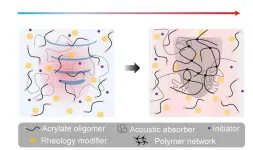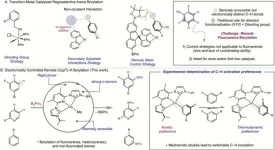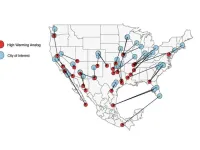(Press-News.org) How heavy can an element be? An international team of researchers has found that ancient stars were capable of producing elements with atomic masses greater than 260, heavier than any element on the periodic table found naturally on Earth. The finding deepens our understanding of element formation in stars.
We are, literally, made of star stuff. Stars are element factories, where elements constantly fuse or break apart to create other lighter or heavier elements. When we refer to light or heavy elements, we’re talking about their atomic mass. Broadly speaking, atomic mass is based on the number of protons and neutrons in the nucleus of one atom of that element.
The heaviest elements are only known to be created in neutron stars via the rapid neutron capture process, or r-process. Picture a single atomic nucleus floating in a soup of neutrons. Suddenly, a bunch of those neutrons get stuck to the nucleus in a very short time period – usually in less than one second – then undergo some internal neutron-to-proton changes, and voila! A heavy element, such as gold, platinum or uranium, forms.
The heaviest elements are unstable or radioactive, meaning they decay over time. One way that they do this is by splitting, a process called fission.
“The r-process is necessary if you want to make elements that are heavier than, say, lead and bismuth,” says Ian Roederer, associate professor of physics at North Carolina State University and lead author of the research. Roederer was previously at the University of Michigan.
“You have to add many neutrons very quickly, but the catch is that you need a lot of energy and a lot of neutrons to do so,” Roederer says. “And the best place to find both are at the birth or death of a neutron star, or when neutron stars collide and produce the raw ingredients for the process.
“We have a general idea of how the r-process works, but the conditions of the process are quite extreme,” Roederer says. “We don’t have a good sense of how many different kinds of sites in the universe can generate the r-process, we don’t know how the r-process ends, and we can’t answer questions like, how many neutrons can you add? Or, how heavy can an element be? So we decided to look at elements that could be made by fission in some well-studied old stars to see if we could start to answer some of these questions.”
The team took a fresh look at the amounts of heavy elements in 42 well-studied stars in the Milky Way. The stars were known to have heavy elements formed by the r-process in earlier generations of stars. By taking a broader view of the amounts of each heavy element found in these stars collectively, rather than individually as is more common, they identified previously unrecognized patterns.
Those patterns signaled that some elements listed near the middle of the periodic table – such as silver and rhodium – were likely the remnants of heavy element fission. The team was able to determine that the r-process can produce atoms with an atomic mass of at least 260 before they fission.
“That 260 is interesting because we haven’t previously detected anything that heavy in space or naturally on Earth, even in nuclear weapon tests,” Roederer says. “But seeing them in space gives us guidance for how to think about models and fission – and could give us insight into how the rich diversity of elements came to be.”
The work appears in Science and was supported in part by the National Science Foundation and the National Aeronautics and Space Administration.
-peake-
Note to editors: An abstract follows.
“Element abundance patterns in stars indicate fission of nuclei heavier than uranium”
DOI: 10.1126/science.adf1341
Authors: Ian U. Roederer, North Carolina State University; Nicole Vassh, TRIUMF (Tri-University Meson Facility) Vancouver, Canada; Erika M. Holmbeck, Carnegie Observatories, California; Matthew R. Mumpower, Los Alamos National Laboratory; Rebecca Surman, University of Notre Dame; John J. Cowan, University of Oklahoma; Timothy C. Beers, University of Notre Dame; Rana Ezzeddine, University of Florida; Anna Frebel, Massachusetts Institute of Technology; Terese T. Hansen, Stockholm University, Sweden; Vinicius M. Placco, NSF’s National Optical-Infrared Astronomy Research Laboratory; Charli M. Sakari, San Francisco State University
Published: Dec. 7, 2023 in Science
Abstract:
The heaviest chemical elements are naturally produced by the rapid neutron-capture process (r-process) during neutron star mergers or supernovae. The r-process production of elements heavier than uranium (transuranic nuclei) is poorly understood and inaccessible to experiments so must be extrapolated by using nucleosynthesis models. We examined element abundances in a sample of stars that are enhanced in r-process elements. The abundances of elements ruthenium, rhodium, palladium, and silver (atomic numbers Z = 44 to 47; mass numbers A = 99 to 110) correlate with those of heavier elements (63 ≤ Z ≤ 78, A > 150). There is no correlation for neighboring elements (34 ≤ Z ≤ 42 and 48 ≤ Z ≤ 62). We interpret this as evidence that fission fragments of transuranic nuclei contribute to the abundances. Our results indicate that neutron-rich nuclei with mass numbers >260 are produced in r-process events.
END
DURHAM, N.C. -- Engineers at Duke University and Harvard Medical School have developed a bio-compatible ink that solidifies into different 3D shapes and structures by absorbing ultrasound waves. Because it responds to sound waves rather than light, the ink can be used in deep tissues for biomedical purposes ranging from bone healing to heart valve repair.
This work appears on December 7 in the journal Science.
The uses for 3D-printing tools are ever increasing. Printers create prototypes of medical devices, design flexible, ...
For the first time, a team of Princeton physicists have been able to link together individual molecules into special states that are quantum mechanically “entangled.” In these bizarre states, the molecules remain correlated with each other—and can interact simultaneously—even if they are miles apart, or indeed, even if they occupy opposite ends of the universe. This research was recently published in the journal Science.
“This is a breakthrough in the world of molecules because of the fundamental importance of quantum entanglement,” said Lawrence Cheuk, assistant professor of physics at Princeton ...
Key takeaways
People in parts of Africa communicate with a wild bird, the greater honeyguide, to locate bee colonies and harvest their honey and beeswax.
A study by UCLA anthropologist Brian Wood and other authors show how this partnership is maintained and varies across cultures.
They demonstrate the bird’s ability to learn distinct vocal signals traditionally used by different honey-hunting communities.
In parts of Africa, people communicate with a wild bird — the greater honeyguide — in order to locate bee colonies and harvest their stores of honey and beeswax.
It’s a rare example of ...
November 30, 2023 – Ongoing quality improvement data submitted by Board-certified plastic surgeons highlight current trends in surgical technique in cosmetic breast augmentation using implants, reports a study in the December issue of Plastic and Reconstructive Surgery®, the official medical journal of the American Society of Plastic Surgeons (ASPS). The journal is published in the Lippincott portfolio by Wolters Kluwer.
"The findings illustrate evolving trends in breast enhancement over the past 16 years, including factors like the location of the incision and the type and positioning of implants," comments lead author Michael J. Stein, ...
The Chirik Group at the Princeton Department of Chemistry is chipping away at one of the great challenges of metal-catalyzed C–H functionalization with a new method that uses a cobalt catalyst to differentiate between bonds in fluoroarenes, functionalizing them based on their intrinsic electronic properties.
In a paper published this week in Science, researchers show they are able to bypass the need for steric control and directing groups to induce cobalt-catalyzed borylation that is meta-selective.
The lab’s research ...
Human noroviruses cause acute gastroenteritis, a global health problem for which there are no vaccines or antiviral drugs. Although most healthy patients recover completely from the infection, norovirus can be life-threatening in infants, the elderly and people with underlying diseases. Estimates indicate that human noroviruses cause approximately 684 million illnesses and 212,000 deaths annually.
“Human noroviruses are highly diverse,” said first author Dr. Wilhelm Salmen, a graduate student in Dr. B V Venkataram Prasad’s lab while he was working ...
When temperatures drop and roads get slick, rock salt is an important safety precaution used by individuals, businesses, and local and state governments to keep walkers, cyclists, and drivers safe. However, according to a new scientific review paper from a team of researchers at Virginia Tech and the University of Maryland, the human demand for salt comes at a cost to the environment.
Published in the journal Nature Reviews Earth & Environment with researchers Stanley Grant, Megan Rippy, and Shantanu Bhide from Virginia Tech’s Occoquan Watershed Monitoring Laboratory, ...
An unexpectedly high percentage of children, who were born with HIV and started treatment within 48 hours of life, exhibit biomarkers by 2 years of age that may make them eligible to test for medication-free remission, according to a multinational study published in Lancet HIV.
“Moving away from reliance on daily antiretroviral therapy (ART) to control HIV would be a huge improvement to the quality of life of these children,” said Protocol Co-Chair and senior author Ellen Chadwick, MD, former Director of Section ...
UNIVERSITY PARK, Pa. – Modern-day Ciudad Mante, Mexico, could help Tampa, Florida, plan for shifting water and electricity demands due to climate change, according to an international team of researchers. Led by Renee Obringer, assistant professor of energy and mineral engineering at Penn State, the researchers used utilities data and climate analogs — contemporary cities with climates close to what other cities are predicted to experience in the future — to assess how climate change may impact residential water and electricity use across 46 cities in the United States.
Their computationally efficient model projected strong regional differences for future water and electricity ...
The lab of Yongchao C. Ma, PhD, at Stanley Manne Children’s Research Institute at Ann & Robert H. Lurie Children’s Hospital of Chicago uncovered a novel mechanism that leads to motor neuron degeneration in spinal muscular atrophy (SMA). This discovery offers a new target for treatment that overcomes important limitations of gene therapy and other current therapies for SMA.
SMA is a genetic disease that disrupts the nerve cells that control voluntary muscle movement. Symptoms of motor neuron degeneration could start at as early as 3 months of ...





